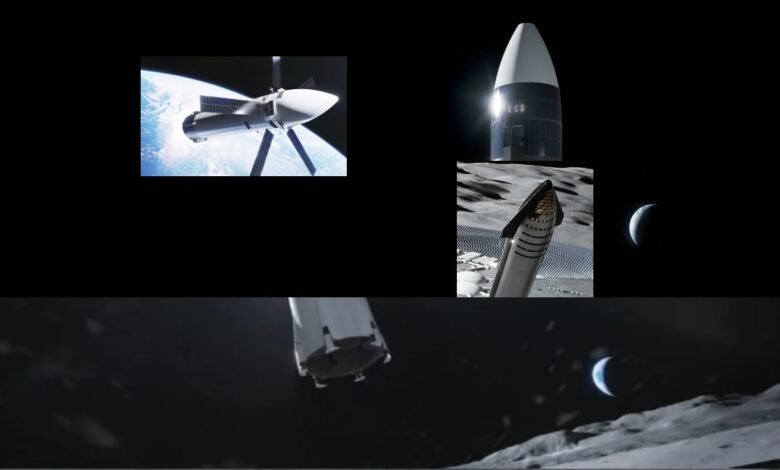
SpaceX launched Starship on its most ambitious test flight yet, achieving record altitude and speed before a fiery re-entry ended in a controlled descent. SpaceX launched Starship on its most ambitious test flight yet, achieving record altitude and speed before a fiery re-entry resulted in a controlled descent, but not a landing. This flight is a critical step towards fulfilling NASA’s Artemis program goals of returning humans to the Moon by 2026.
Key Points: SpaceX launched
Third Time’s a Charm (Partially): Starship completed most mission objectives, showcasing its potential for spaceflight. However, communication was lost before a targeted ocean landing.
Powerful and Pioneering: This behemoth stands taller than the Statue of Liberty and boasts the highest thrust of any operational rocket.
Moon Mission Critical: Success with Starship is vital for NASA’s Artemis program, aiming to return humans to the Moon by 2026.
Rapid Development Strategy: SpaceX embraces a learn-by-doing approach, with valuable data gleaned from previous Starship test flight mishaps.
Competition Heats Up: China’s space ambitions are growing, targeting a crewed lunar landing by 2030.
Starship Makes Strides: Despite the landing setback, the mission successfully completed many objectives, showcasing Starship’s potential for future deep space missions, especially for NASA.
Powerhouse Performance: This behemoth stands taller than the Statue of Liberty and boasts the highest thrust of any operational rocket, paving the way for lunar and Martian exploration.
Collaboration for Moon Mission: A successful Starship is crucial for NASA’s Artemis program. Starship would serve as the lunar lander, transporting astronauts to the lunar surface.
Rapid Development with Risks: SpaceX’s commitment to rapid development through real-world testing has yielded valuable data despite the previous Starship test flight mishaps. This iterative approach is essential for Starship’s success.
Space Race Heats Up: China’s space ambitions are growing, targeting a crewed lunar landing by 2030, putting pressure on SpaceX to refine Starship’s capabilities.
Detailed Look: SpaceX launched
The third test flight of Starship, a fully-stacked behemoth designed for deep space exploration, marked a significant milestone for SpaceX. While the targeted ocean landing wasn’t achieved, the mission successfully completed many objectives crucial for future space endeavors, particularly NASA’s Artemis program. The third test flight of the fully-stacked Starship marks a significant milestone for SpaceX, particularly for its role in NASA’s Artemis program. While the targeted ocean landing wasn’t achieved, the mission successfully completed many objectives vital for future space endeavors, especially those involving NASA.
Powerhouse Performance: SpaceX launched
With a staggering thrust exceeding NASA’s Space Launch System (SLS), Starship is the most powerful operational rocket ever built. This innovative design, standing 400 feet tall, paves the way for future missions to the Moon, Mars, and beyond.
Unmatched Power:
With a staggering thrust exceeding NASA’s Space Launch System (SLS), Starship is the most powerful operational rocket ever built. This innovative design, standing 400 feet tall, paves the way for future missions to the Moon, Mars, and beyond, directly supporting NASA’s deep space exploration goals.
Crucial for NASA’s Artemis Program: SpaceX launched
Starship is a key component of NASA’s Artemis program, aiming to return astronauts to the Moon by 2026. A successful Starship would serve as the lunar lander, transporting astronauts to the lunar surface. With China aiming for a crewed lunar landing by 2030, the pressure is on for SpaceX to refine Starship’s capabilities.
Critical for Artemis:
Starship is a key component of NASA’s Artemis program, aiming to return astronauts to the Moon by 2026. A successful Starship would serve as the lunar lander, transporting astronauts to the lunar surface. With China aiming for a crewed lunar landing by 2030, the pressure is on for SpaceX to refine Starship’s capabilities to meet NASA’s Artemis timeline.
Read More:–
Learning from Every Launch:
SpaceX’s commitment to rapid development through real-world testing has proven successful in the past. While the first two Starship test flights resulted in fiery explosions, valuable data was collected to improve the design. This iterative approach is crucial for achieving Starship’s full potential.
SpaceX’s commitment to rapid development through real-world testing has proven successful in the past. While the first two Starship test flights resulted in fiery explosions, valuable data was collected to improve the design. This iterative approach is crucial for achieving Starship’s full potential, ensuring its role in NASA’s Artemis mission.
The Road Ahead: Conclusion
Future Starship missions will involve sending multiple “Starship tankers” into orbit to refuel a main Starship for its onward journey, a complex operation requiring further testing. Despite the setback during re-entry, this third test flight signifies significant progress for Starship, bringing the dream of lunar exploration a step closer to reality. Future Starship missions will involve sending multiple “Starship tankers” into orbit to refuel a main Starship for its onward journey, a complex operation requiring further testing. Despite the setback during re-entry, this third test flight signifies significant progress for Starship, bringing the dream of lunar exploration a step closer to reality, especially for NASA’s Artemis program.



